Free weights can be intimidating, especially for beginners. But there's no need to fear, machines are here! Machine-guided exercises help you locate an appropriate starting point, learn safe lifting motions, and understand vital weak points.
Experienced lifters use machines to safely increase strength and weight for large muscle groups. It's the same for beginners. Machines isolate muscle groups and help determine where you need the most work. Over time, adding weight with guided movement can also prepare you for the plunge into free weights.
Get the down-low on machines and take your training to the next level. Beginners should start with a lightweight, high-rep range: three sets of 10 reps. Increase weight and change sets and reps only when you feel comfortable and ready. Patience is a virtue! Strength is a necessity!
1. Horizontal Chest Press
Horizontal chest press machines target the chest, triceps and shoulders by simulating a bench press. Use a close grip (palms facing down) to work the chest and triceps. Use a neutral grip (palms facing each other) to incorporate the shoulders.
To operate a horizontal chest press machine:
- Sit with your back pressed firmly against the back pad.
- Place your hands on the handles and take a deep breath in.
- Exhale while extending your elbows, but don't lock them.
- Pause at the top and slowly lower the weight back to the starting position.
Get a detailed look at horizontal chest presses on the Exercise Database.
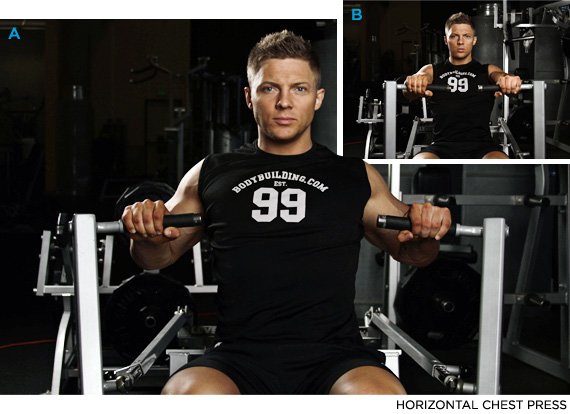
2. Seated High Row
Seated high row machines attack the back and biceps simultaneously, providing balance for the upper body. The machine may not make sense visually immediately, so take your time and get comfortable with it.
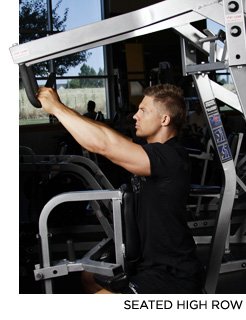
To operate a horizontal row machine:
- Sit with your chest pressed firmly into the pad.
- Grasp the handles and take a deep breath in.
- Keep your back upright and your chest against the pad. Pull the weight toward you as you exhale.
- Pull back as far you comfortably can, reverse direction, and slowly let the weight out.
Get a detailed look at horizontal rows on the Exercise Database.
3. Lat Pull-Down
The lat pull-down machine is a popular stop even for weightlifters who prefer free weights. Pull-downs are essentially reverse pull-ups that increase the width and definition of the back. Alternate between wide and narrow grips to stress different muscles. A wide grip targets the sides of your back; a narrow grip blasts the mid-back and biceps.
To operate a lat pull-down machine:
- Sit on the bench with your body upright.
- Grasp the bar with an overhand grip, or use an underhand grip for more emphasis on the biceps.
- Lean backward slightly, keeping the spinal column mostly erect, and pull the weight down.
- Lower the bar toward your sternum, pause, and let the weight rise until your elbows are extended, but not locked.
Get a detailed look at lat pull-downs on the Exercise Database.
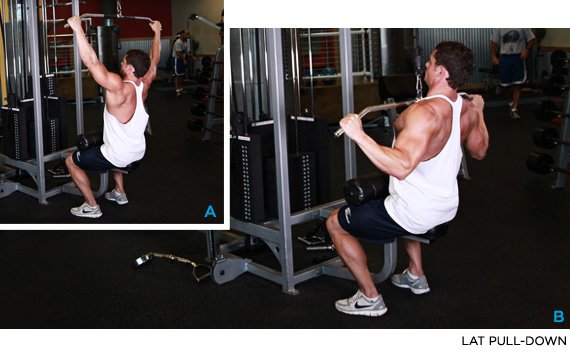
4. Seated Shoulder Press
The seated shoulder press hits every shoulder muscle and works the triceps. Performing this exercise with a machine decreases the risk of lower back pain, which some people experience when performing shoulder presses with free weights.
To operate a shoulder press machine:
- Make sure your lower back stays in contact with the back pad at all times.
- Grasp the handles, get a feel for the weight, and breathe in.
- While exhaling, push the weight over your head until the arms are straight, but not locked.
- Pause for a brief moment, get control, and lower the weight to complete a rep.
Get a detailed look at seated shoulder presses on the Exercise Database.

{{caption}}
5. Pec Flye
Pec flye machines, also known as "pec decks," mimic dumbbell chest flyes by isolating chest muscles. Everyone wants a stronger chest, so don't be surprised if you have to camp out by this popular machine.
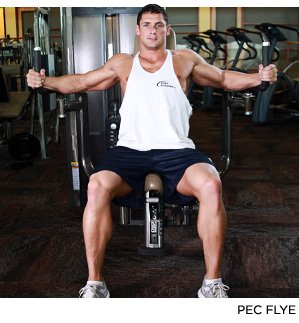
To operate a pec flye machine:
- Sit with your back pressed firmly against the back pad.
- Grasp the handles or place your arms behind the side arm pads (depending on the machine).
- Contract the chest muscles to move your hands and arms toward the center of your body. Avoid using your arm or shoulder muscles to ensure you target the chest.
- Pause when your hands meet and reverse directions slowly back into the starting position. Never allow your hands to go beyond parallel with your shoulders to avoid stress on shoulder joints.
Get a detailed look at pec flyes on the Exercise Database.
6. Triceps Dip
Assisted dips isolate the triceps in the same manner as a triceps extension or reverse kickback. Work them into your routine and you'll outgrow the assistance in no time!
To operate a triceps dip machine:
- Sit down and place both hands firmly on the handles without gripping them tightly.
- Take in a deep breath and exhale while pressing the handles downward until your elbows straighten, but are not locked or hyperextended.
- Pause for a moment and allow the weight back up into the starting position as you inhale.
Get a detailed look at triceps dips on the Exercise Database.
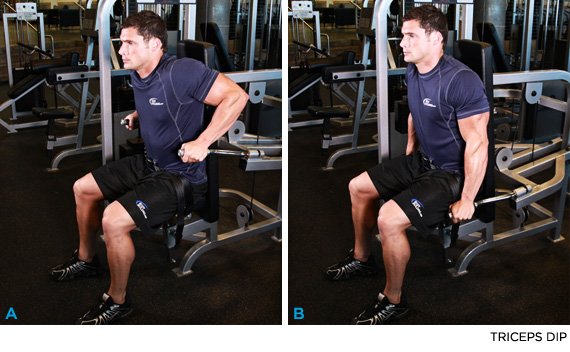
{{caption}}
7. Biceps Curl
This is the perfect complement to triceps dips. Biceps curl machines isolate the biceps and help build pythons!
To operate a biceps curl machine:
- Sit on the bench with your back in an upright position.
- Place your elbows comfortably on the pad, keeping your arms bent.
- Grab the handles and slowly pull them toward you while exhaling.
- Pause at the top of the movement and reverse directions slowly. It should burn!
Get a detailed look at biceps curls on the Exercise Database.
8. Leg Press
Leg presses hammer the lower body (glutes, hamstrings and quads) and build explosive power. People suffering from back pain can use this machine as a substitute for squats.
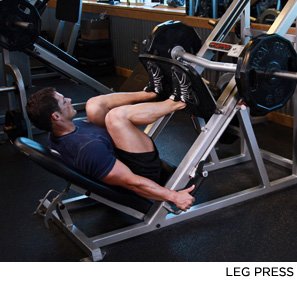
To operate a leg press machine:
- Lie down in the machine and plant both feet slightly wider than hip-width apart. Try a narrow stance to place more stress on the quads and less on the hamstrings.
- Get comfortable, then press through the legs and push the weight upward until your knees are extended. Never hyperextend or lock the knees, since this places high stress on joints.
- Pause briefly and bend your knees slowly, bringing the weight back down to the starting position.
Get a detailed look at leg presses on the Exercise Database.
9. Leg Extension
Leg extension machines isolate the quads, making it the perfect exercise to enhance definition and finish a brutal leg day. Those suffering from knee pain should proceed with caution; leg extensions can put stress on joints.
To operate a leg extension machine:
- Sit firmly and place your feet under the foot pad with the back against the back pad.
- Keeping the toes pointed forward, slowly extend your legs until they're extended but not locked. Pause for a brief movement at the top and lower the leg to complete a rep.
- Never drop the weight back down! Use slow and controlled movements to maintain tension.
Get a detailed look at leg extensions on the Exercise Database.
10. Hamstring Curl
Hamstring curls should be performed in conjunction with leg extensions to target the opposing side of the leg. Perform hamstring curls after leg presses or go back-to-back (which is called a "superset") with leg extensions.
To operate a hamstring curl machine:
- Place your legs on top of the foot pad while seated, or lay down on the bench with your legs under the pad (depending on the type of machine).
- Slowly curl the weight toward your butt by bending the knees.
- Curl as far as you can comfortably go, pause briefly, and reverse direction.
Get a detailed look at hamstring curls on the Exercise Database.

11. Seated Calf Raise
As Arnold says, "Don't forget about your calves!" Strong calves are important because we use our lower legs in movements all day long, from walking to climbing flights of stairs.
To operate a seated calf raise machine:
- Sit down and place your knees under the pads and your feet on the foot rest.
- Press through the toes and raise heels upward, lifting the weight with your calves.
- Pause at the top of the movement and lower back down to complete the rep.
Get a detailed look at seated calf raises on the Exercise Database.

12. Standing Calf Raise
Standing calf raises are a great alternative to seated calf raises. They're usually done with bodyweight, by switching feet angles to stress muscles differently, but the machine provides a nice crash course.
To operate a standing calf raise machine:
- Stand on the platform with your shoulders underneath the pads.
- Slowly lift your heels and rise up onto your toes.
- Pause at the top and lower back down to complete the rep. Breaking the horizontal plane works the calves more intensely.
Get a detailed look at standing calf raises on the Exercise Database.
13. Leg Adductor
Leg adductor machines isolate the inner thighs. Women often believe this machine helps create thinner thighs, but that's not the case. If anything, this machine may cause larger thighs by adding muscular strength. Have realistic expectations, but don't skip this machine!
To operate a leg adductor machine:
- Sit with your back flat against the back pad.
- Place your knees behind the pads with bent legs and your feet on the foot platforms.
- Slowly squeeze your legs together by contracting the inner thighs.
- Pause at the end and reverse directions, bringing you back into the starting position.
Get a detailed look at leg adductors on the Exercise Database.
14. Leg Abductor
The leg abductor opposes the leg adductor, targeting the outer thigh and glute. Anyone looking for a shapely backside should hop on this machine.
To operate a leg abductor machine:
- Sit with your back flat against the back pad.
- Place your feet on the platforms with the knee pads against the outside of your knee.
- Open the legs to move the weight outward as far as you can.
- Pause briefly and reverse direction, bringing the legs together.
Get a detailed look at leg abductors on the Exercise Database.

15. Abdominal Crunch
Abdominal crunch machines are where your 6-pack begins! This machine is perfect if you want to avoid neck-tweaking sit-ups.
To operate an abdominal crunch machine:
- Sit on the bench with your chest behind the chest pad and your feet firmly planted.
- Contract the abdominal muscles and slowly crunch forward as far down as possible.
- Pause briefly and reverse directions, maintaining a slow movement.
Get a detailed look at abdominal crunches on the Exercise Database.

